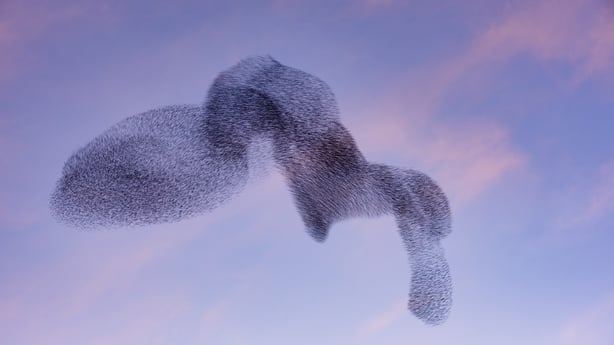Brian Burke from Birdwatch Ireland tells The Ray D'Arcy Show about The Irish Starling Murmuration Survey. Listen back above.
From the end of February through to mid-March, starling murmurations can be spotted at dusk at certain locations across the country. These spectacular waves of birds which form ever-changing patterns in the sky are the focus of a survey by Birdwatch Ireland, who are appealing to the public to register sightings of murmurations on their website.
Brendan Courtney spoke to Brian Burke from Birdwatch Ireland on the Ray D’Arcy Show about The Irish Starling Murmuration Survey and some of the places people can go to witness these amazing aerial antics.
Brian Burke says it’s impossible to know for sure why starlings perform these elaborate sky dances - sometimes in flocks numbering in the hundreds of thousands. He says it could be to muster safety in numbers or to signal feeding or roosting areas to other birds.

No-one knows what's going on in the starling's heads, he says; but it’s definitely part of their bedtime routine:
"They gather in absolutely huge numbers to spend the night in the same area and before they settle down in forestry or in a reed bed for the night, they do these amazing spectacles; flying over and back and up and down and splitting in all directions in the sky. It’s just a spectacle that I think a lot of people wouldn’t have seen before."
From the dying days of winter into early March is the best period to spot a murmuration. Brian says it’s well worth making the effort to try and witness the spectacle and the sunset timeline of the event makes the visual impact all the more dramatic:
"If you get a nice winter sky, a little bit of colour in it, it’s just absolutely amazing - it’s unforgettable stuff, really."
One of the most reliable spots to witness the phenomenon is the eastern end of Lough Ennell near Mullingar; but there are others, Brian says:
"There’s Fedamore outside Limerick, there’s Ferns in Wexford and there’s a spot in Kilkenny – Clomantagh."
Taking time to look up at the sky; paying attention to how the birds are moving across the sky and listening to the sounds they are making – all of this is probably good for our mental health, Brendan suggests.
Brian agrees: "No matter what age you are, whether you’re into your birds or not, this is something really, really special and something people maybe don’t think you can see in Ireland – but you can. So, I really do encourage people to go out and look for it."
Ireland is one of the few places in Europe where the breeding population of starlings is not in decline, Brian says. Participation in the Starling Murmuration Survey could help to secure the habitats favoured by starlings for future generations:
"We want to see the sites that these birds rely on – these hundreds of thousands of starlings - that they rely on, given some consideration and given some protection so that we’ll have this into the future."
You can find out more and add your sightings to the national data on Birdwatch Ireland’s website here.
And if you’d like to hear what starlings – and other Irish birds - sound like, subscribe to Seán Ronayne’s Bird Songs podcast here.
